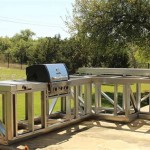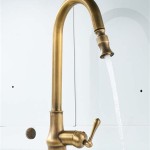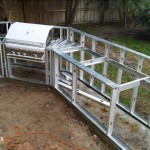Kitchen Sinks: An Undermount Installation Guideline
Selecting a kitchen sink is a critical decision that impacts both the functionality and aesthetics of a kitchen space. Among the various installation types available, undermount sinks have risen in popularity due to their sleek appearance and ease of cleaning. This guideline will provide a comprehensive overview of undermount kitchen sinks, covering their advantages, disadvantages, installation process, and crucial considerations for a successful project.
An undermount sink is installed beneath the countertop, with the countertop material extending over the sink's edge, creating a seamless transition. This contrasts with top-mount or drop-in sinks, where the sink's rim rests on the countertop. The resulting clean lines of an undermount sink contribute to a modern and sophisticated kitchen design. Furthermore, they are often perceived as easier to maintain due to the absence of a visible rim where debris can accumulate.
Choosing the right undermount sink involves several factors, including the sink material, size, bowl configuration (single bowl, double bowl, or triple bowl), and the overall style of the kitchen. Stainless steel remains a popular choice due to its durability, stain resistance, and affordability. However, other materials such as granite composite, cast iron, and copper are also available, each offering unique aesthetic and performance characteristics.
The size of the undermount sink should be carefully considered in relation to the countertop space and the intended use. Larger sinks are suitable for handling bulky pots and pans, while smaller sinks may be more appropriate for smaller kitchens or secondary prep areas. The bowl configuration should also align with the cooking and cleaning habits of the user. Single bowl sinks offer maximum space for washing large items, while double bowl sinks provide separate compartments for washing and rinsing.
Before embarking on an undermount sink installation, it is essential to ensure that the countertop material is suitable. Undermount sinks require a solid surface countertop, such as granite, quartz, marble, or solid surface acrylic, as they rely on the countertop's structural integrity for support. Laminate countertops are generally not recommended for undermount sink installations due to their susceptibility to water damage and lack of sufficient support.
Key Point 1: Advantages of Undermount Sinks
Undermount sinks offer several distinct advantages that contribute to their widespread appeal. The primary advantage is their aesthetic appeal. The seamless integration with the countertop creates a clean and modern look that enhances the overall design of the kitchen. The absence of a visible rim also eliminates a potential area for the accumulation of dirt and grime, making cleanup easier. Food particles and spills can be directly wiped from the countertop into the sink without obstruction.
Another advantage of undermount sinks is the increased countertop space. By mounting the sink underneath the countertop, the full surface area of the countertop is available for food preparation and other tasks. This is particularly beneficial in smaller kitchens where every inch of countertop space is valuable. The smooth transition between the countertop and the sink also provides a more ergonomic work surface.
Furthermore, undermount sinks offer greater flexibility in terms of countertop material selection. As they rely on the countertop for support, undermount sinks can be paired with a wide range of high-end countertop materials, allowing for customized design choices. The use of solid surface countertops with undermount sinks creates a durable and long-lasting combination that can withstand the rigors of daily kitchen use.
Key Point 2: Disadvantages and Considerations
While undermount sinks offer numerous benefits, there are also some potential disadvantages and considerations to keep in mind. The primary disadvantage is the higher installation cost associated with undermount sinks. The installation process is more complex than that of top-mount sinks, requiring specialized tools and expertise. The countertop must be precisely cut to match the sink's dimensions, and the sink must be securely attached to the underside of the countertop using adhesives and mounting clips.
Another consideration is the potential for water damage if the installation is not properly executed. If the sink is not properly sealed to the countertop, water can seep between the sink and the countertop, leading to mold and mildew growth. It is crucial to use a high-quality sealant specifically designed for kitchen sinks and to ensure that all gaps and seams are completely sealed.
Additionally, undermount sinks may require more robust support structures beneath the countertop, especially for larger and heavier sinks. The countertop must be able to bear the weight of the sink and any water or items placed inside it. In some cases, additional bracing or reinforcement may be necessary to prevent sagging or cracking of the countertop.
Key Point 3: Installation Process and Best Practices
The installation of an undermount sink is a multi-step process that requires careful planning and execution. The first step is to create an accurate template of the sink's cutout dimensions. This template will be used to guide the cutting of the countertop. It is crucial to follow the manufacturer's instructions closely and to double-check the measurements before cutting.
Once the countertop is cut, the edges should be smoothed and polished to prevent chipping and cracking. The sink can then be attached to the underside of the countertop using epoxy adhesive and mounting clips. Apply a generous bead of sealant around the rim of the sink before attaching it to the countertop. This will create a watertight seal and prevent water from seeping between the sink and the countertop.
After the adhesive has cured, the plumbing connections can be made. Connect the drain to the sink's drain opening and attach the water supply lines to the faucet. Be sure to use Teflon tape on all threaded connections to prevent leaks. Finally, test the sink for leaks by filling it with water and checking all connections for any signs of water seepage. If any leaks are detected, tighten the connections or reapply sealant as needed.
Maintaining an undermount kitchen sink requires regular cleaning to prevent the buildup of stains and grime. Use a mild dish soap and a soft sponge or cloth to clean the sink after each use. Avoid using abrasive cleaners or scouring pads, as they can scratch the sink's surface. For stubborn stains, use a solution of baking soda and water or a commercial cleaner specifically designed for the sink material.
Periodically inspect the sealant around the sink's rim for any signs of cracking or deterioration. If the sealant is damaged, remove the old sealant and reapply a fresh bead of sealant. This will help to prevent water damage and maintain the sink's watertight seal. With proper installation and maintenance, an undermount kitchen sink can provide years of reliable performance and enhance the beauty of the kitchen.
When choosing an undermount sink, consider the faucet style and hole configuration. Some sinks come with pre-drilled holes for faucets and accessories, while others require the faucet to be mounted on the countertop. Ensure that the faucet style complements the sink's design and that the hole configuration matches the faucet's requirements.
Proper lighting around the kitchen sink is essential for both safety and functionality. Install adequate lighting above the sink to provide clear visibility for food preparation and cleaning tasks. Consider using under-cabinet lighting to illuminate the countertop area around the sink, creating a more inviting and functional workspace.
In summary, undermount kitchen sinks provide an elegant and practical solution for modern kitchens. By understanding their advantages, disadvantages, and installation requirements, homeowners can make informed decisions that result in a beautiful and functional kitchen space. Selecting the right sink material, size, and configuration, along with proper installation and maintenance, will ensure a long-lasting and aesthetically pleasing addition to the home.

Ruvati 57 Inch Dual Tier Workstation Large Barndominium Kitchen Sink Undermount Rvh8555 Usa

Kitchen Sink Types A Definitive Guide

Karran Undermount Quartz Single Bowl Kitchen Sink Black

Ruvati 28 Inch Undermount Kitchen Sink 50 Double Bowl 16 Gauge Stainless Steel Rvm5077 Usa

Karran Undermount 32 25 In X 19 Black Quartz Single Bowl Kitchen Sink Qu 812 Bl At Com

Lange Stainless Steel 32 Single Bowl Farmhouse Apron Front Undermount Kitchen Sink Sinkology Finish Brushed

User Guide For The 33 Inch Double Bowl Workstation Kitchen Sink

The Ultimate Guide To Choosing Perfect Undermount Sink

Ruvati 32 Inch Workstation Ledge Undermount 16 Gauge Stainless Steel Kitchen Sink Single Bowl Rvh8300 Usa
Kitchen Sink Guide Signature Hardware
Related Posts








